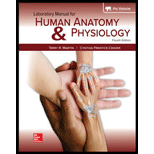
The __________ is a skull bone that is not interlocked along sutures.
- mandible
- maxilla
- temporal bone
- occipital bone
Introduction:
The skeletal structure supporting the formation of the head and guards the brain is known as skull or cranium. The cranium or skull is further divided into facial bones and cranial bones. A suture is a fibrous joint that is present in the skull.
Answer to Problem 1PL
Correct answer:
The correct answer is option (a) mandible.
Explanation of Solution
Explanation/justification for the correct answer:
Option (a) mandible. The cranial system consists of a total of 22 bones. Among which 8 bones are of cranium and 14 bones are facial bones. The mandible comes under facial bone. It is the lower jaw in humans. Mandible is the largest bone of the facial skeleton and is not joined by any suture. Therefore, this is the correct answer.
Explanation for incorrect answer:
Option (b) Maxilla. Maxilla is a part of the facial skeleton and forms the upper jaw in humans. It is composed of two maxillary bones that are joined by intermaxillary suture, and form anterior nasal spine. Therefore, this is an incorrect answer.
Option (c) Temporal bone. It is a part of the 8 cranium bones that form the sidewalls of the skull. Temporal bone is connected to other bones of the skull by different sutures such as squamosal suture that connects temporal bone with lower border of the parietal bone and occipitomastoid suture that joins the temporal bone with the occipital bone. Therefore, this is an incorrect answer.
Option (d) Occipital bone. It is one of the 8 bones of the cranium that forms its lower back area. It is trapezoidal-shaped. Occipital bone fuses with parietal bone through lambdoid suture. And mastoid portion of the temporal bone and occipital bone is fused through occipitomastoid suture. Therefore, this is an incorrect answer.
Thus, option (a) mandible that forms the lower jaw is a skull bone that is not interlocked along sutures.
Want to see more full solutions like this?
Chapter 14 Solutions
Laboratory Manual For Human Anatomy & Physiology
Additional Science Textbook Solutions
Principles of Anatomy and Physiology
Anatomy & Physiology (6th Edition)
Essentials of Human Anatomy & Physiology (11th Edition)
Marine Biology (Botany, Zoology, Ecology and Evolution)
- The ____________________ bone is located just below the urinary bladder. ilium ischium pubis sacrumarrow_forwardThe upper portion of the sternum is the ____________________. clavicle mandible manubrium xiphoid processarrow_forwardAn osteochondroma is a benign bony projection covered with cartilage. ______ _______ _______ _______arrow_forward
- An osterrhaphy is the surgical suturing, or wiring together, of bones._________________arrow_forwardParts of the sphenoid bone include the ________. sella turcica squamous portion glabella zygomatic processarrow_forwardSpondylolisthesis is the forward slipping movement of the body of one of the lower lumbar vertebrae on the vertebra or sacrum below it. ______ _______ _______ _______arrow_forward
- The opening in a bone through which blood vessels, nerves, and ligaments pass is a ____________. foramen foramina process symphysisarrow_forwardA normal projection on the surface of a bone that serves as an attachment for muscles and tendons is known as a/an___________ cruciate exostosis popliteal processarrow_forwardBaby Juanita was treated for ______________, which is congenital deformity of the foot involving the talus ankle bone. Her family calls this condition clubfoot. osteomalacia rickets scoliosis talipesarrow_forward
- In an accident, Felipe Valladares broke several bones in his fingers. The medical term for these injuries is fractured ______________________.arrow_forwardPart of the elbow is formed by the ________________end of the humerus. distal lateral medial proximalarrow_forwardThe tibia ________. has an expanded distal end called the lateral malleolus is not a weight-bearing bone is firmly anchored to the fibula by an interosseous membrane can be palpated (felt) under the skin only at its proximal and distal endsarrow_forward
 Medical Terminology for Health Professions, Spira...Health & NutritionISBN:9781305634350Author:Ann Ehrlich, Carol L. Schroeder, Laura Ehrlich, Katrina A. SchroederPublisher:Cengage Learning
Medical Terminology for Health Professions, Spira...Health & NutritionISBN:9781305634350Author:Ann Ehrlich, Carol L. Schroeder, Laura Ehrlich, Katrina A. SchroederPublisher:Cengage Learning Anatomy & PhysiologyBiologyISBN:9781938168130Author:Kelly A. Young, James A. Wise, Peter DeSaix, Dean H. Kruse, Brandon Poe, Eddie Johnson, Jody E. Johnson, Oksana Korol, J. Gordon Betts, Mark WomblePublisher:OpenStax College
Anatomy & PhysiologyBiologyISBN:9781938168130Author:Kelly A. Young, James A. Wise, Peter DeSaix, Dean H. Kruse, Brandon Poe, Eddie Johnson, Jody E. Johnson, Oksana Korol, J. Gordon Betts, Mark WomblePublisher:OpenStax College



